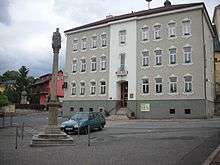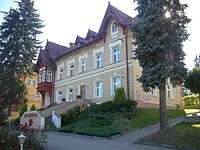Luby (Cheb District)
| Luby | |||
| Town | |||
| | |||
|
|||
| Country | Czech Republic | ||
|---|---|---|---|
| Region | Karlovy Vary | ||
| District | Cheb | ||
| Commune | Cheb | ||
| Elevation | 518 m (1,699 ft) | ||
| Coordinates | CZ 50°15′09″N 12°24′21″E / 50.25250°N 12.40583°ECoordinates: CZ 50°15′09″N 12°24′21″E / 50.25250°N 12.40583°E | ||
| Area | 30.71 km2 (11.86 sq mi) | ||
| Population | 2,515 (2005) | ||
| Density | 82/km2 (212/sq mi) | ||
| Mayor | Karel Kubeš | ||
| Timezone | CET (UTC+1) | ||
| - summer (DST) | CEST (UTC+2) | ||
| Postal code | 351 37 | ||
  Location in the Czech Republic | |||
| Wikimedia Commons: Luby | |||
| Statistics: statnisprava.cz | |||
| Website: www | |||
Luby is a Czech Republic town located in the Cheb District. Before 1946, it was known as Schönbach. It is well known for its violin-making industry, and was once dubbed the "Austrian Cremona" when Bohemia was part of Austria-Hungary.
Historic timeline
400–1500: Middle Ages
- During the Middle Ages, Schönenbach served as the community center for the area countryside, and was referred to as Schönbacher Ländchens ("Beautiful Little Country Brook"). During the mid-13th Century in Upper Schönenbach (Horni Luby), mercury ore, particularly the vermilion variety, was mined in the area. In the 16th Century, the ore was regarded as the most important in Central Europe. In 1536, about 200 miners had produced about 13.5 tons of cinnabar from several area mines.
1618–1648: Thirty Years' War
- During the Thirty Years' War, the mining came to a complete standstill. In the latter-half of the 17th Century, Schönbach flourished as a center of violin making.
1867–1918: Schönbach, Austria-Hungary
- Schönbach was part of the Austro-Hungarian Empire. The village was located within the boundaries of the Eger District created by the Austria-Hungary monarchy. In 1900, Schönbach gained access to electricity and the railroad, which allowed the city to ramp-up production of goods, including musical instruments.
1918–1938: Schönbach, Czechoslovakia
- The Austro-Hungarian Empire collapsed in 1918, after World War I, and Schönbach became part of Czechoslovakia. In 1929, about 1,500 Schönbach craftsmen were employed making string instruments.
1938–1945: Schönbach, Germany (during the occupation)
- In 1938, following the Great Depression, Germany took possession of the western region of Czechoslovakia known as the Sudetenland, and occupied it until the end of World War II.
1946–1992: Luby, Czechoslovakia
- In 1946, right after World War II, Czechoslovakia restored the pre-1938 border and changed the name "Schönbach" (a German name) to "Luby" (a Czech name). Following the 1948 Czechoslovak coup d'état, Czechoslovakia fell under communist rule. In 1949, residents with German ethnicity were expelled from Czechoslovakia. About two-thirds of the Schönbach population were German, among which, about 1,600 were instrument makers. The instrument makers mostly settled in Bubenreuth of Erlangen, which, before then, only had about 500 residents. Bubenreuth was, at that time, in the American zone of what became West Germany.
Notable luthiers and music instrument companies
Music instrument merchants & companies[1]
- Hoyer guitars
- John Juzek
- Violin Making School in Schönbach
- Framus
- Höfner, founded 1887 in Schönbach
- Strunal CZ a.s.
- Cremona (1948 to 1992), absorbed by CSHN in 1965
- Czechoslovak Musical Instruments (CSHN) (1948 to 1992)
Violin makers[1]
- Angerer, Kaspar (born 1789)
- Angerer, Philipp (approx. 1618)
- Bitterer, Andreas (1858–1954)
- Bitterer, Georg (1886–1955)
- Bitterer, Josef (1902–1970)
- Brandner, Johann (1849–1912)
- Brandner, Karl (1891–1965)
- Bruckner, Ferdinand [Nandor] (1848–1912)
- Fuchs, Wenzel (1900–1985)
- Goth, Willi (born 1913)
- Heinicke, Josef (1878–1966)
- Himmer, Alban (1874–1942)
- Himmer, Josef (1839–1898)
- Himmer, Josef (1894–1961)
- Himmer, Josef (1898–1969)
- Hofner, Karl (1864–1955)
- Klier, Franz Josef (1901–1962)
- Kohler, Karl (born 1891)
- Kurz, Hans (born approx. 1753)
- Lutz, Anton (1895–1932)
- Markert, Ignaz (1891–1974)
- Mettal, Ignaz (1869–1941)
- Neudorfer, Franz (1885–1955)
- Neudorfer, Franz (1900–1948)
- Neudorfer, Ignaz (1861–1933)
- Neudorfer, Josef (1880–1960)
- Neudorfer, Rudolf (born 1910)
- Ringer, Josef (1844–1908)
- Sandner, Andreas (1871–1946)
- Sandner, Egid (1851–1918)
- Schuster, Rudolf (1888–1955)
- Sommer, Anton (born 1900)
- Sommer, Egyd [Agidius] (1863–1913)
- Stubiger, Adam (1859–1925)
- Trasny, Hans (1894–1969)
- Trasny, Josef (1825–1905)
- Volkmann, Heinrich (1865–1936)
- Wilfer, Anton (1866–1920)
- Wilfer, Anton (1898–1973)
- Winter, Anton (1888–1963)
Guitar makers[1]
- Hanika, Helmut (born 1931)
- Mettal, Rudolf (1896–1953)
- Potzl, Rudolf (1874–1950)
- Potzl, Wenzel (1869–1949)
In 1948, when the communist party took power in Czechoslovakia, the production of music instruments was nationalized and unified into a single Luby-based company called Cremona that had been in existence since 1920. All manufactures and small workshops were part of this company. In 1992, Cremona was privatized and renamed "Strunal," which since as exported under the label of Josef Jan Dvorak (for bowed instruments) and Strunal or Amada (for guitars). Strunal, in its corporate literature, purports to be the largest manufacturer of stringed musical instruments in Europe. The name Strunal is derived from the Czech spelling of "String" ("Struna") and "Luby."
Images
| Images from Luby, Czech Republic | ||||||
|---|---|---|---|---|---|---|
|
See also
References
- 1 2 3 Heimatbuch der Musikstadt Schönbach (Music City Schönbach), edited by the Festival Committee for the 650-Year Celebration of Schöenbach, published in Bubenreuth (1969) OCLC 615201359




